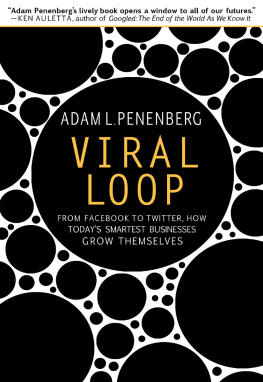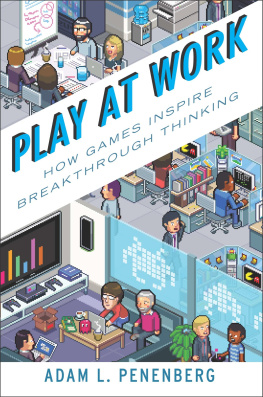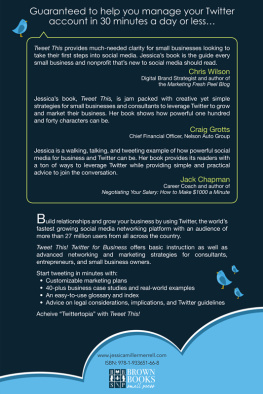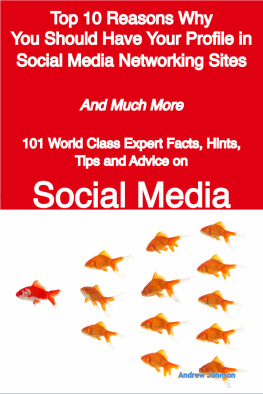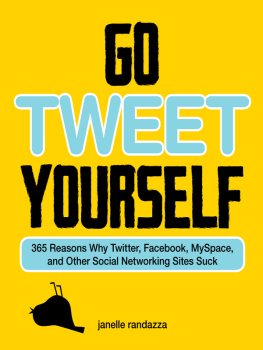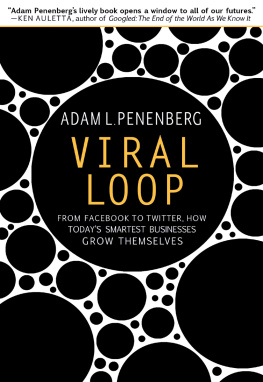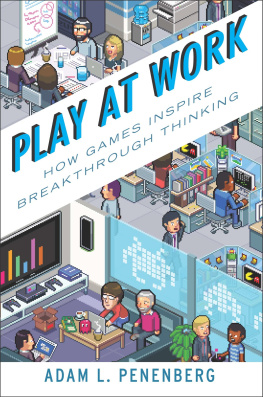Adam L. Penenberg - Viral Loop: From Facebook to Twitter, How Todays Smartest Businesses Grow Themselves
Here you can read online Adam L. Penenberg - Viral Loop: From Facebook to Twitter, How Todays Smartest Businesses Grow Themselves full text of the book (entire story) in english for free. Download pdf and epub, get meaning, cover and reviews about this ebook. year: 2009, publisher: Hachette Books, genre: Detective and thriller. Description of the work, (preface) as well as reviews are available. Best literature library LitArk.com created for fans of good reading and offers a wide selection of genres:
Romance novel
Science fiction
Adventure
Detective
Science
History
Home and family
Prose
Art
Politics
Computer
Non-fiction
Religion
Business
Children
Humor
Choose a favorite category and find really read worthwhile books. Enjoy immersion in the world of imagination, feel the emotions of the characters or learn something new for yourself, make an fascinating discovery.
- Book:Viral Loop: From Facebook to Twitter, How Todays Smartest Businesses Grow Themselves
- Author:
- Publisher:Hachette Books
- Genre:
- Year:2009
- Rating:4 / 5
- Favourites:Add to favourites
- Your mark:
- 80
- 1
- 2
- 3
- 4
- 5
Viral Loop: From Facebook to Twitter, How Todays Smartest Businesses Grow Themselves: summary, description and annotation
We offer to read an annotation, description, summary or preface (depends on what the author of the book "Viral Loop: From Facebook to Twitter, How Todays Smartest Businesses Grow Themselves" wrote himself). If you haven't found the necessary information about the book — write in the comments, we will try to find it.
Viral Loop: From Facebook to Twitter, How Todays Smartest Businesses Grow Themselves — read online for free the complete book (whole text) full work
Below is the text of the book, divided by pages. System saving the place of the last page read, allows you to conveniently read the book "Viral Loop: From Facebook to Twitter, How Todays Smartest Businesses Grow Themselves" online for free, without having to search again every time where you left off. Put a bookmark, and you can go to the page where you finished reading at any time.
Font size:
Interval:
Bookmark:
[ From Facebook to Twitter, How Todays Smartest Businesses Grow Themselves ]

To the Penengirls,
Charlotte, Lila, and Sophie
An Insanely Viral Scheme
How the Guys from Hot or Not Rode a Simple Idea to a Fortune
Viral President
Positive Feedback Loop, Spreadable Concepts, and the Three Categories of Viral Expansion Loops
Viral Businesses
Tupperware and Ponzi Schemesthe Original Viral Models
Party Plans, Referral Networks, and Sizzlemanship
The First Online Viral Expansion Loop
Mosaic, Netscape, Network Effects, and the Spark that Touched Off the Internet Boom
The Spreadable Product as New Business Paradigm
Viral Plain, Nings Double Viral Loop, Your Digital Self, and Crushing Crushlink
Viral Marketing
The Perpetual Viral Advertisement
Viral Tag: P.S. I Love You. Get Your Free Email at Hotmail
When the Audience Decides Whats Good
Collective Curation; Boom, Bust, and Beyond, and the Viral Reality Show of Your Life
Viral Video as Marketing Strategy (Psst. Pass It On)
Letting Go of Your Brand, Joke Cycles, and Not Acting Like Some Guy in His Mid-40s Trying to Be a Hipster
Viral Networks
eBay and the Viral Growth Conundrum
Faster, Pussycat. Scale! Scale! Scale!
PayPal: The First Stackable Network
Viral Synergy, Greedy Inducements, Scalable Fraud, and Battle of the Network All Stars
Flickr, YouTube, MySpace
Spreadable Spreadables, Stackable Stackables, and the Point of Nondisplacement
Tweaking the Viral Coefficient
Bebo, Patterns in Virality, and Critical Mass
Viral Clusters
Facebook, the Social Graph, and Thingamajigs
The Search for a New Ad Unit
Death to the Traditional Banner Advertisement, the Arms Race Between Marketers and Consumers, and Time (Not Clicks)
How the Guys from Hot or Not Rode a Simple Idea to a Fortune
Two Heinekens into a lazy Tuesday afternoon, James Hong, a twenty-seven-year-old dot-com refugee from Mountain View, California, was listening to his roommate, Jim Young, a Berkeley graduate student in electrical engineering, wax on about a woman he had spotted at a party the previous weekend. Young, also twenty-seven, insisted she was a perfect 10. Hong didnt believe him. He knew his roommate had a thing for goth, while Hongs own tastes were more Abercrombie & Fitch. What the world needed, they agreed, was a metric to reliably rate someones looks.
The two out-of-pocket entrepreneurs werent just in a frat-like buzz obsessing over women who likely wouldnt give them a second look. This exchange was the logical outgrowth of a broader discussion they had been having about Web services, something that had long been on Hongs mind. At the time, October 2000, Web services focused on business-to-business applications, but Hong wondered about a consumer playa product that would appeal to regular people. A year earlier, he and Young had toyed with the idea of creating a dating site with collaborative filtering to better cluster people: users would scan a series of pictures, then express an opinion as to how attractive the person was. This, they reasoned, could increase the efficiency of dating, although it didnt end up spawning an actual business. Now he and his roommate were ginning up more ideas for a start-up.
Youngs perfect ten comment got Hong thinking. What if you could rate someones looks by opening it up to a vote? Most people believed they were above average, which was, statistically speaking, impossible. Hong, an athletic extrovert with a buzz cut and zingy wit, rated himself a 7. And his skinny partner with the modish, foppish hair? About the same, but who really knew? In the way the value of a house or used car was whatever someone was willing to paythat is, whatever the market would beara persons attractiveness could be based on whatever a large community of people judged it to be. For it to work, all they would need were pictures and a grid from 1 to 10 for site visitors to click on. Then they would crunch the aggregate data and spit out the results. Hong didnt know many people who had a whiteboard in their living room, but he and Young did, and they quickly drew up plans. Burned out on his dissertation, Young figured it could be an entertaining diversion and suggested they build a simple website instead of a vastly more complicated Web service.
Hong scoured the Web for candid shotshe wanted real people, not Sports Illustrated swimsuit modelswhile Young got cracking on the digital infrastructure, cobbling it together with Linux code. A couple of days later, while visiting his parents, Hong was tinkering with the site when in walked his father, a Taiwanese-born engineer who wore pocket protectors and had given him a slide rule for his thirteenth birthday. If he found out what his unemployed son was working on, he would shake his head and mutter that he was wasting his education. Hong told him it was all Youngs idea.
Peering over his sons shoulder, his father looked at the photo on the screen. Oh, shes hot. Shes an eight, he said. Hong could scarcely believe his ears. He was half convinced his father had engaged in sex only three times in his lifewhen he, his brother, and his sister were conceived. Without prompting, his father clicked on another photo. Not so hot, he clucked. Then click. Click, click, click, until he pored through the entire cache of photosforty in all.
His father was hooked. Because of the way Hong and his partner designed the site, a user couldnt find out the poll results until he voted and the next page loaded. They purposely placed the aggregate score on the left side over a smaller version of the picture while the next picture, significantly larger, sat front and center. The idea was to train a users eyes to flow from the middle to the left. Because there was always one more photo to be judged, a user would feel compelled to cast another vote. It was like the old Lays potato chip ad: Betcha cant eat just one. The interface demanded engagement, and this in turn made it sticky. If a site retained a visitors interest, it had the potential to be popular and spread by powerful word-of-mouth endorsement.
When his father was out of earshot, Hong phoned his roommate. Dude, we have to launch this thing right now!
[ GOING VIRAL ]
On Monday, October 9, 2000, Am I Hot or Not went live, not that anyone but its two founders knew about it. Hong emailed forty-two friends (partly, he said, because forty-two was the answer to life, the universe and everything in the cult sci-fi classic The Hitchhikers Guide to the Galaxy). Heres a website that Jim and I madebe nice, he wrote and inserted a link to their own pictures. Soon after, visitors pinged the site, quickly spreading well beyond Hongs forty-two friends. It didnt take an epidemiologist to recognize a viral spread in the making. To test it, Hong slipped on a pair of Rollerblades and skated across the street to an office park where Tellme, a software call center and services provider, was located. He glided over to an office worker in the parking lot.
Hey, have you seen this website where you can rate people if they are hot or not? Hong asked.
He hadnt. Hong told him and bladed home. Inside ten minutes Tellmes IP address appeared in the site logs. Hong monitored the mans activities as he clicked through the photos. Suddenly more Tellme IP addresses popped up. Clearly the man had shared the link with coworkers, who then passed it to others. A drizzle turned into a full-blown storm, with the hits coming in fast and furious from all over the country. Traffic swarmed their borrowed server; the site slowed to a crawl. It took half a minute for each page to load.
Font size:
Interval:
Bookmark:
Similar books «Viral Loop: From Facebook to Twitter, How Todays Smartest Businesses Grow Themselves»
Look at similar books to Viral Loop: From Facebook to Twitter, How Todays Smartest Businesses Grow Themselves. We have selected literature similar in name and meaning in the hope of providing readers with more options to find new, interesting, not yet read works.
Discussion, reviews of the book Viral Loop: From Facebook to Twitter, How Todays Smartest Businesses Grow Themselves and just readers' own opinions. Leave your comments, write what you think about the work, its meaning or the main characters. Specify what exactly you liked and what you didn't like, and why you think so.

